Pawpaw, Papaya
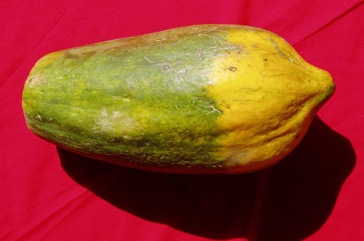
It is a tropical plant. Pawpaws will grow from sea level up to about 1700 m altitude in the equatorial tropics. In cooler regions they have to be planted but in humid tropical regions are commonly self sown. Sunlight allows germination when forest is cleared. Plants cannot stand frost. A temperature of 25-30°C is suitable. They need a night temperature above 12°C. Also they cannot stand water-logging. Plants die after 48 hours in standing water. It needs a pH between 5-8. It suits hardiness zones 11-12. In XTBG Yunnan.
Also known as:
Ai-dila, Alola, Amapaapali, Babaya, Babbaay, Baos, Barus, Barush, Bataa maal, Bhanta, Boppayi, Bulung botik, Chipapayi, Daun papaya, Delolo, Du du, Esi, 'Esu, Falhoa, Fruta bomba, Gaslabu, Gedang, Gui su bao, Gwanda, Ibekpe, Igi bekpe, Jhoda, Jin gua biu, Kancha pepe, Kates, Keinabbu, Keiniap, Kepaya, Ketela, Ma-la-ko, Mak-sang-hpaw, Malagoh, Malaka, Mamiyap, Mamao, Mamon, Manioko, Mbabayu, Maoli uto, Mamiap, Me mao si, Memiap, Mewa, Mpapai, Mulola, Oleti, Ololo, Omita schein, Papaali, Papaeira, Papaia, Papaja, Papeeta, Papita, Pappaiya, Pappali, Pappayam, Parangi-mara, Pepaya, Pepol, Pai-pai, Pepe, Ran falho, Rangu falho, Ru gua, Sanghpaw, Te mwemweara, Thinbaw, Thingfanghma, Veyo falho, Voampazalahy, Wapaya, Weleti, Yapeertora
Synonyms
- Carica peltata Hook. & Arn.
- Carica posoposa L.
- Carica sativa Tussac
- Papaya carica Gaertn.
- Papaya edulis Bojer
- Papaya vulgaris A DC.
- and others
Edible Portion
- Fruit, Flowers, Leaves, Vegetable, Seeds - spice
Where does Pawpaw grow?
Found in: Afghanistan, Africa, Amazon, American Samoa, Andamans, Angola, Antigua and Barbuda, Argentina, Aruba, Asia, Australia, Bahamas, Bangladesh, Barbados, Belize, Benin, Bermuda, Bolivia, Bougainville, Brazil, British Indian Ocean Terr., BIOT, Burkina Faso, Burundi, Cambodia, Cameroon, Caribbean, Caroline Islands, Central Africa, Central America, Chile, China, Christmas Island, Chuuk, Colombia, Congo DR, Congo, Cook Islands, Costa Rica, Côte d'Ivoire, Cuba, Dominica, Dominican Republic, East Africa, East Timor, Ecuador, El Salvador, Ethiopia, Fiji, FSM, French Guiana, Gabon, Gambia, Ghana, Grenada, Guadeloupe, Guam, Guatemala, Guianas, Guinea, Guinée, Guinea-Bissau, Guyana, Haiti, Hawaii, Himalayas, Honduras, India, Indochina, Indonesia, Ivory Coast, Jamaica, Japan, Kenya, Kiribati, Laos, Lesser Antilles, Liberia, Madagascar, Malawi, Malaysia, Maldives, Mali, Mamao, Mariana Islands, Marquesas, Marshall Islands, Martinique, Mauritius, Mexico, Micronesia, Mozambique, Myanmar, Nauru, Nepal, New Caledonia, Nicaragua, Niger, Nigeria, North America, Northeastern India, Pacific, Pakistan, Palau, Panama, Papua New Guinea, PNG, Paraguay, Peru, Philippines, Pohnpei, Puerto Rico, Rotuma, Samoa, São Tomé and Príncipe, Saudi Arabia, SE Asia, Senegal, Sierra Leone, Sikkim, Solomon Islands, Somalia, South Africa, South America, South Sudan, Southern Africa, Sri Lanka, St Lucia, St. Vincent and Grenadines, Suriname, Taiwan, Tanzania, Thailand, Timor-Leste, Togo, Tokelau, Tonga, Trinidad and Tobago, Turks & Caicos, Tuvalu, Uganda, United States, Vanuatu, Venezuela, Vietnam, Virgin Islands, Wallis and Futuna, West Africa, West Indies, West Papua, West Timor, Yap, Zambia, Zimbabwe
Notes: Now only one species is included and the others are put in the Vasconcellea. It possibly has anti-cancer properties. Fruit are reasonably high in folates 62-97μg/100.
Status: It is a common and cultivated fruit tree. In Papua New Guinea it occurs in all lowland areas in gardens and bush. Trees are near houses in the highlands. The fruit is popular for snacks and baby food. It is sold in local markets.
Growing Pawpaw, Papaya
Cultivation: Pawpaw seeds grow easily and plants grow quickly. Fresh seeds can be used, or if dry seeds are used they should be soaked before planting. Seeds should be planted with a temperature of 24-30°C. To produce well they need a reasonably fertile soil. Seeds can be sown directly or the seeds can be put in a nursery and the seedlings transplanted. Seeds in a nursery should be about 1-2 cm deep. Seedlings can be transplanted when they are about 20 cm high. Plants should be about 3 m apart. Continuous fruit production depends on fertility, temperature and moisture being adequate to maintain active growth. The fruit is produced year round but the growth and development rate decreases with temperature. Also the size and quality of fruit declines at lower temperatures. Pollination is by wind and insects. Normally cross and self pollination both occur. Pollination is not normally limiting. Seeds are widely dispersed by birds, bats and people. Seeds remain viable for a few months and also germinate freely.
Edible Uses: Fruit can be eaten ripe and raw. Green fruit can be cooked as a vegetable. The young leaves can be eaten cooked, but are bitter. The flowers and the middle of the stem can be eaten. Papayas contain papain which is a meat tenderiser. The dried seeds can be used as a spice.
Production: Seeds emerge in 2 to 3 weeks. Vegetative growth before flowering is 4-8 months. Fruit is produced as one or more per leaf axil, about every 1-2 weeks, under good growing conditions. So with good growth 100 fruit can be produced from one plant in a year. Fruit development from pollination to maturity is about 2-3 months. On the coast in tropical equatorial regions, pawpaws start producing fruit after about 4 or 5 months but in the highlands this may not start for 12-18 months. The first fruit produced and ripe, are ready 6-11 months from planting. Practical tree life is about 2 to 3 years, although trees may live for 10-12 years.
Nutrition Info
per 100g edible portion| Edible Part | Energy (kcal) | Protein (g) | Iron (mg) | Vitamin A (ug) | Vitamin c (mg) | Zinc (mg) | % Water |
|---|---|---|---|---|---|---|---|
| Fruit | 39 | 0.5 | 0.4 | 290 | 54 | 0.18 | 88 |
| Leaves | 90 | 8 | 0.77 | - | 140 | - | 75.4 |
| Fruit unripe | 26 | 1 | 0.3 | - | - | - | 92.1 |
Pawpaw, Papaya Photos

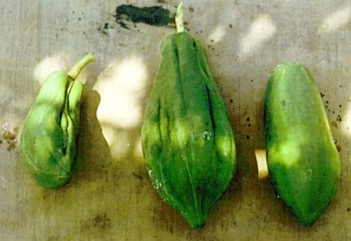
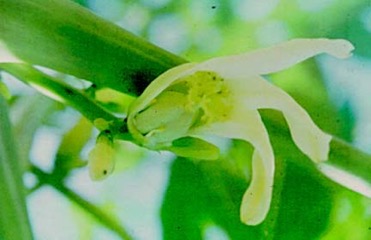
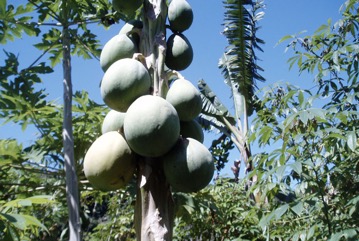
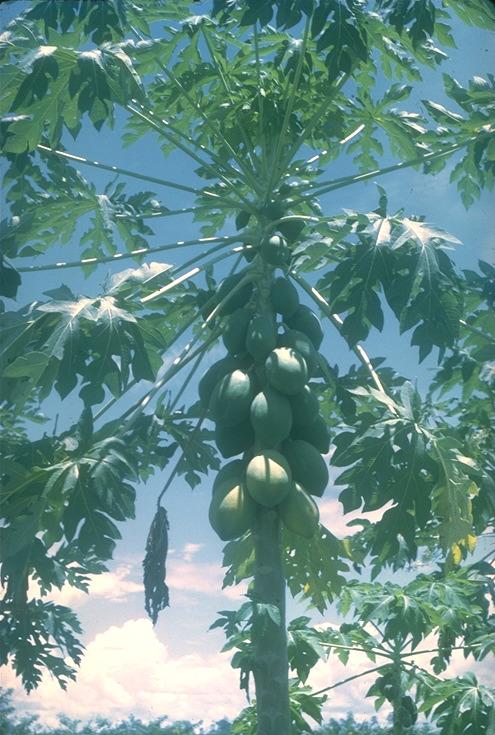
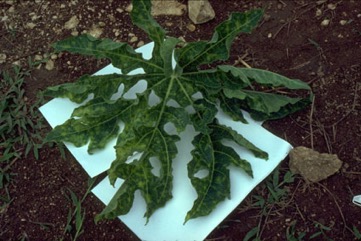
References
AAK, 1980, Bertanam Pohon Buah-buahan. Penerbitan Yayasan Kanisius, Jogyakarta. p 48
Abbiw, D.K., 1990, Useful Plants of Ghana. West African uses of wild and cultivated plants. Intermediate Technology Publications and the Royal Botanic Gardens, Kew. p 41
Acipa, A. et al, 2013, Nutritional Profile of some Selected Food Plants of Otwal and Ngai Counties, Oyam District, Northern Uganda. African Journal or Food, Agriculture, Nutrition and Development. 13(2)
Ali, A. M. S., 2005, Homegardens in Smallholder Farming Systems: Examples from Bangladesh. Human Ecology, Vol. 33, No. 2 pp. 245-270
Ambasta S.P. (Ed.), 2000, The Useful Plants of India. CSIR India. p 105
Anderson, E. F., 1993, Plants and people of the Golden Triangle. Dioscorides Press. p 205
Arellanes, Y., et al, 2013, Influence of traditional markets on plant management in the Tehuacan Valley. Journal of Ethnobiology and Ethnomedicine 9:38
Awasthi, A.K., 1991, Ethnobotanical studies of the Negrito Islanders of Andaman Islands, India - The Great Andamanese. Economic Botany 45(2) pp274-280.
Bennett, B. C., 1990, Useful Plants of Amazonian Ecuador. US Agency for International Development. Fifth Progress Report. New York Botanical Gardens. p 40
Bernholt, H. et al, 2009, Plant species richness and diversity in urban and peri-urban gardens of Niamey, Niger. Agroforestry Systems 77:159-179
Bianchini, F., Corbetta, F., and Pistoia, M., 1975, Fruits of the Earth. Cassell. p 172
Bircher, A. G. & Bircher, W. H., 2000, Encyclopedia of Fruit Trees and Edible Flowering Plants in Egypt and the Subtropics. AUC Press. p 83 (As Carica peltata) and p 83 (As Carica posopora)
Bodkin, F., 1991, Encyclopedia Botanica. Cornstalk publishing, p 215
Bodner, C. C. and Gereau, R. E., 1988, A Contribution to Bontoc Ethnobotany. Economic Botany, 43(2): 307-369
Borrell, O.W., 1989, An Annotated Checklist of the Flora of Kairiru Island, New Guinea. Marcellin College, Victoria Australia. p 60
Bourret, D., 1981, Bonnes-Plantes de Nouvelle-Caledonie et des Loyaute. ORSTOM. p 48
Bradacs, G., 2008, Ethnobotanical Survey and Biological Screening of Medicinal Plants from Vanuatu. PhD thesis Frankurt University. p 101
Bremness, L., 1994, Herbs. Collins Eyewitness Handbooks. Harper Collins. p 43
Brouk, B., 1975, Plants Consumed by Man. Academic Press, London. p 190
Brown, D., 2002, The Royal Horticultural Society encyclopedia of Herbs and their uses. DK Books. p 155
Burkill, H. M., 1985, The useful plants of west tropical Africa, Vol. 1. Kew.
Burkill, I.H., 1966, A Dictionary of the Economic Products of the Malay Peninsula. Ministry of Agriculture and Cooperatives, Kuala Lumpur, Malaysia. Vol 1 (A-H) p 464
Cabalion, P. and Morat, P., 1983, Introduction le vegetation, la flore et aux noms vernaculaires de l'ile de Pentcoste (Vanuatu), In: Journal d'agriculture traditionnelle et de botanique appliquee JATBA Vol. 30, 3-4
Cao, Y., et al, 2020, Ethnobotanical study on wild edible plants used by three trans-boundary ethnic groups in Jiangcheng County, Pu’er, Southwest China. Journal of Ethnobiology and Ethnomedicine (2020) 16:66
Catarino, L., et al, 2016, Ecological data in support of an analysis of Guinea-Bissau's medicinal flora. Data in Brief 7 (2016):1078-1097
Chandrashekara, U. M., 2009, Tree species yielding edible fruit in the coffee-based homegardens of Kerala, India: their diversity, uses and management. Food Sec. 1:361-370
Cheifetz, A., (ed), 1999, 500 popular vegetables, herbs, fruits and nuts for Australian Gardeners. Random House p 174
Chin, H.F., & Yong, H.S., 1996, Malaysian Fruits in Colour. Tropical press, Kuala Lumpur p 16
Cobley, L.S. (rev. Steele, W.M.) 2nd Ed., 1976, An Introduction to the Botany of Tropical Crops. Longmans. p 181
Coe, F. G. and Anderson, G. J., 1999, Ethnobotany of the Sumu (Ulwa) of Southeastern Nicaragua and Comparisons with Miskitu Plant Lore. Economic Botany Vol. 53. No. 4. pp. 363-386
Condit, R., et al, 2011, Trees of Panama and Costa Rica. Princeton Field Guides. p 118
Coronel, R.E., 1982, Fruit Collections in the Philippines. IBPGR Newsletter p 6
Cowie, I, 2006, A Survey of Flora and vegetation of the proposed Jaco-Tutuala-Lore National Park. Timor-Lests (East Timor) www.territorystories.nt/gov.au p 45
Cribb, A.B. & J.W., 1976, Wild Food in Australia, Fontana. p 162
Cronin, L., 1989, The Concise Australian Flora. Reed. p 169
Cruz, I. M., et al, 2015, Edible fruits and seeds in the State of Mexico. Revista Mexicana de Ciencias Agricolas. Vol. 6. Num. 2 pp 331-346
Cull, B.W., 1995, Fruit Growing in Warm Climates. Reed. p 131
Cundall, P., (ed.), 2004, Gardening Australia: flora: the gardener's bible. ABC Books. p 330
Darley, J.J., 1993, Know and Enjoy Tropical Fruit. P & S Publishers. p 89
Das, T. & Das, A. K., 2005, Inventorying plant biodiversity in homegardens: A case study in Barak Valley, Assam, North East India. CURRENT SCIENCE, VOL. 89, NO. 1, 10 JULY 2005
Dharani, N., 2002, Field Guide to common Trees & Shrubs of East Africa. Struik. p 209
Ekman Herbarium records Haiti
Esperanca, M. J., 1988. Surviving in the wild. A glance at the wild plants and their uses. Vol. 2. p 122
Etherington, K., & Imwold, D., (Eds), 2001, Botanica's Trees & Shrubs. The illustrated A-Z of over 8500 trees and shrubs. Random House, Australia. p 181
FAO, 1988, Traditional Food Plants, FAO Food and Nutrition Paper 42. FAO Rome p 135
Flowerdew, B., 2000, Complete Fruit Book. Kyle Cathie Ltd., London. p 153
Focho, D. A., et al, 2009, Ethnobotanical survey of Trees in Fundong, Northwest Region, Cameroon. Journal of Ethnobiology and Ethnomedicine, 5:17
Fowler, D. G., 2007, Zambian Plants: Their Vernacular Names and Uses. Kew. p 17
Franklin, J., Keppel, G., & Whistler, W., 2008, The vegetation and flora of Lakeba, Nayau and Aiwa Islands, Central Lau Group, Fiji. Micronesica 40(1/2): 169–225, 2008
French, B.R., 1986, Food Plants of Papua New Guinea, A Compendium. Asia Pacific Science Foundation p 203
French, B.R., 2010, Food Plants of Solomon Islands. A Compendium. Food Plants International Inc. p 202
Furusawa, T., et al, 2014, Interaction between forest biodiversity and people's used of forest resources in Roviana, Solomon Islands: implications for biocultural conservation under socioeconomic changes. Journal of Ethnobiology and Ethnomedicine, 10:10
Garner, R.J., and Chaudhri, S.A., (Ed.) 1976, The Propagation of Tropical fruit Trees. FAO/CAB. p 304
Giraldi, M. & Hanazaki, N., 2014, Use of Cultivated and Harvested Edible Plants by Caiçaras—What Can Ethnobotany Add to Food Security Discussions? Human Ecology Review, Volume 20, Number 2, 2014
Goode, P., 1989, Edible Plants of Uganda. FAO p 27
Goode, P., 1989, Edible Plants of Uganda. FAO p 40
Grandtner, M. M., 2008, World Dictionary of Trees. Wood and Forest Science Department. Laval University, Quebec, Qc Canada. (Internet database http://www.WDT.QC.ca)
Grandtner, M. M. & Chevrette, J., 2013, Dictionary of Trees, Volume 2: South America: Nomenclature, Taxonomy and Ecology. Academic Press p 101
Hearne, D.A., & Rance, S.J., 1975, Trees for Darwin and Northern Australia. AGPS, Canberra p 38
Hedrick, U.P., 1919, (Ed.), Sturtevant's edible plants of the world. p 162 (Also as Carica posoposa)
Hermandez Bermejo, J.E., and Leon, J. (Eds.), 1994, Neglected Crops. 1492 from a different perspective. FAO Plant Production and Protection Series No 26. FAO, Rome. p15
Heywood, V.H., Brummitt, R.K., Culham, A., and Seberg, O. 2007, Flowering Plant Families of the World. Royal Botanical Gardens, Kew. p 88
INFOODS:FAO/INFOODS Databases
Jacquat, C., 1990, Plants from the Markets of Thailand. D.K. Book House p 53
Jardin, C., 1970, List of Foods Used In Africa, FAO Nutrition Information Document Series No 2.p 64, 124
John, L., & Stevenson, V., 1979, The Complete Book of Fruit. Angus & Robertson p 210
Juarez-Rojop, I. E., et al, 2012, Hypoglycemic effect of Carica papaya leaves in streptozotocin-induced diabetic rats. BMC Complementary and Alternative Medicine, 12:236
Kahlon, L. K. & Singh, R., 2019, Traditional knowledge & Dynamics of edible plants of primitive tribal group ‘Paudi Bhuyan’ with changing demography migration patterns in Northern Odisha. Indian Journal of Traditional Knowledge Vol 18(1), pp 7-15
Katende, A.B., Birnie, A & Tengnas B., 1995, Useful Trees and Shrubs for Uganda. Identification, Propagation and Management for Agricultural and Pastoral Communities. Technical handbook No 10. Regional Soil Conservation Unit, Nairobi, Kenya. p 158
Khan, D. & Shaukat, S.S., 2006, The Fruits of Pakistan: Diversity, Distribution, Trends of Production and Use. Int. J. Biol. Biotech., 3(3):463-499
Khodram,S. D., et al, 2019, Local knowledge of edible flowers used in Mizoram. Indian Journal of Traditional Knowledge Vol 18(40 pp 715-723
Kiple, K.F. & Ornelas, K.C., (eds), 2000, The Cambridge World History of Food. CUP p 1828
Kujawska, M. & Luczaj, L., 2015, Wild Edible Plants Used by the Polish Community in Misiones, Argentina. Human Ecology 43:855-869
Kumar, A., et al, 2012, Ethnobotanical Edible Plant Biodiversity of Lepcha Tribes. Indian Forester, 138 (9):798-803
Kumar, S. A., Manus, D. & Mallika, M., 2018, Impact of non-timber forest products on Forest and in Livelihood Economy of the People of Adjoining Areas of Jalpaiguri Forest Division, West Bengal, India. Int. J. of Life Sciences, 2018; 6 (2):365-385
Kuo, W. H. J., (Ed.) Taiwan's Ethnobotanical Database (1900-2000), http://tk.agron.ntu.edu.tw/ethnobot/DB1.htm
Latham, P., 2004, Useful Plants of Bas-Congo province. Salvation Army & DFID p 69
Lembaga Biologi Nasional, 1977, Buah-Buahan, Balai Pustaka, Jakarta. p 102
Li, D. et al, 2017, Ethnobotanical survey of herbal tea plants from the traditional markets in Chaoshan, China. Journal of Ethnopharmacology. 205 (2017) 195-206
Liu, Yi-tao, & Long, Chun-Lin, 2002, Studies on Edible Flowers Consumed by Ethnic Groups in Yunnan. Acta Botanica Yunnanica. 24(1):41-56
Lorenzi, H., Bacher, L., Lacerda, M. & Sartori, S., 2006, Brazilian Fruits & Cultivated Exotics. Sao Paulo, Instituto Plantarum de Estuados da Flora Ltda. p 374
Lyle, S., 2006, Discovering fruit and nuts. Land Links. p 101
Macmillan, H.F. (Revised Barlow, H.S., et al) 1991, Tropical Planting and Gardening. Sixth edition. Malayan Nature Society. Kuala Lumpur. p 272
Mahony, D., 1991, Trees of Somalia. A Field Guide for Development Workers. Oxfam Research Paper 3. p 9
Manandhar, N.P., 2002, Plants and People of Nepal. Timber Press. Portland, Oregon. p 136
Martin, F.W. & Ruberte, R.M., 1979, Edible Leaves of the Tropics. Antillian College Press, Mayaguez, Puerto Rico. p 60, 181
Martin, F. W., et al, 1987, Perennial Edible Fruits of the Tropics. USDA Handbook 642 p 23
Martin, M.A., 1971, Introduction L'Ethnobotanique du Cambodge. Centre National de la Recherche Scientifique. Paris.
Mbuya, L.P., Msanga, H.P., Ruffo, C.K., Birnie, A & Tengnas, B., 1994, Useful Trees and Shrubs for Tanzania. Regional Soil Conservation Unit. Technical Handbook No 6. p 160
Miguel, E., et al, 1989, A checklist of the cultivated plants of Cuba. Kulturpflanze 37. 1989, 211-357
Molla, A., Ethiopian Plant Names. http://www.ethiopic.com/aplants.htm
Montani, M. C. & Scarpa, G. F., 2016, Recursos vegetales y prácticas alimentarias entre indígenas tapiete del noreste de la provincia de Salta, Argentina. Darwiniana, nueva serie vol.4 no.1 San Isidro jul. 2016
Morley, B.D., & Toelken, H.R., (Eds), 1983, Flowering Plants in Australia. Rigby. p 98
Morton, J. F., 1987, Fruits of Warm Climates. Wipf & Stock Publishers p 336
Murakami, A. et al, 2014, Screening for the In Vitro Anti-tumor-promoting Activities of Edible Plants from Malaysia. Bioscience, Biotechnology, and Biochemistry, 64:1, 9-16.
Murtem, G. & Chaudhrey, P., 2016, An ethnobotanical note on wild edible plants of Upper Eastern Himalaya, India. Brazilian Journal of Biological Sciences, 2016, v. 3, no. 5, p. 63-81
Nathan, A., & Wong Y Chee, 1987, A Guide to Fruits and Seeds, Singapore Science Centre. p 46
Norrington, L., & Campbell, C., 2001, Tropical Food Gardens. Bloomings Books. p 111
NYBG Herbarium "edible"
Ochse, J.J. et al, 1931, Vegetables of the Dutch East Indies. Asher reprint. p 98
Ojelel, S., et al, 2019, Wild edible plants used by communities in and around selected forest reserves of Teso-Karamoja region, Uganda. Journal of Ethnobiology and Ethnomedicine (2019) 15:3
Omawale, 1973, Guyana's edible plants. Guyana University, Georgetown p 31
Oomen, H.A.P.C., & Grubben, G.J.H., 1978, Tropical Leaf Vegetables in Human Nutrition, Communication 69, Department of Agricultural research, RTI Amsterdam, p 22, 36,
Owen, S., 1993, Indonesian Food and Cookery, INDIRA reprints. p 77
Pawera, L., et al, 2020, Wild Food Plants and Trends in Their Use: From Knowledge and Perceptions to Drivers of Change in West Sumatra, Indonesia, Foods. 2020, 9, 1240
Paz, F. S., et al, 2021, Edible Fruit Plant Species in the Amazon Forest Rely Mostly on Bees and Beetles as Pollinators. Journal of Economic Entomology, XX(XX), 2021, 1–13
Peekel, P.G., 1984, (Translation E.E.Henty), Flora of the Bismarck Archipelago for Naturalists, Division of Botany, Lae, PNG. p 389, 388
Perry, F., and Hay, R., 1982, Guide to Tropical and Subtropical Plants. Sun Books p 16
Pham-Hoang Ho, 1999, An Illustrated Flora of Vietnam. Nha Xuat Ban Tre. p 563
Phon, P., 2000, Plants used in Cambodia. © Pauline Dy Phon, Phnom Penh, Cambodia. p 134
Priyadi, H., et al, Five hundred plant species in Gunung Halimun Salak National Park West Java. A checklist including Sundanese names, distribution and use. CIFOR, FFPRI, SLU p 45
Purseglove, J.W., 1968, Tropical Crops Dicotyledons, Longmans. p 45
Raponda-Walker, A & Sillans, R., 1961, Les Plantes Utiles du Gabon. Editions Paul Lechevalier, Paris. p 119
Rashid, H. E., 1977, Geography of Bangladesh. Westview. p 343 (As Carica pepe)
Recher, P, 2001, Fruit Spirit Botanical Gardens Plant Index. www.nrg.com.au/~recher/ seedlist.html p 1
Rosero-Toro, et al, 2018, Cultural significance of the flora of a tropical dry forest in the Doche vereda (Villavieja, Huila, Colombia). Journal of Ethnobiology and Ethnomedicine (2018) 14:22 p 11
Ruiters-Welcome, A. K., 2019, Food plants of southern Africa. Ph.D. thesis. Univ. of Johannesburg p 42
Salako, V. K. et al, 2013, Home gardens: an assessment of their biodiversity and potential contribution to conservation of threatened species and crop wild relatives in Benin. Genet Resour Crop Evol
Schuler, S., (Ed.), 1977, Simon & Schuster's Guide to Trees. Simon & Schuster. No. 187
Segura, S., et al, 2018, The edible fruit species in Mexico. Genet Resour Crop Evol (2018) 65:1767–1793
Segnon, A. C. & Achigan-Dako, E. G., 2014, Comparative analysis of diversity and utilization of edible plants in arid and semi-arid areas in Benin. Journal of Ethnobiology and Ethnomedicine 2014, 10:80
Seidemann J., 2005, World Spice Plants. Economic Usage, Botany, Taxonomy. Springer. p 85
Selvam, V., 2007, Trees and shrubs of the Maldives. RAP Publication No. 2007/12 p 52
Sharma, B.B., 2005, Growing fruits and vegetables. Publications Division. Ministry of Information and broadcasting. India. p 101
Small, E., 2009, Top 100 Food Plants. The world's most important culinary crops. NRC Research Press. p 397
Smith, N., Mori, S.A., et al, 2004, Flowering Plants of the Neotropics. Princeton. p 86 (Drawing)
Solomon, C., 2001, Encyclopedia of Asian Food. New Holland. p 270
Sp. pl. 2:1036. 1753
Sp. pl. 2:1036. 1753 (As Carica posoposa)
Staples, G.W. and Herbst, D.R., 2005, A tropical Garden Flora. Bishop Museum Press, Honolulu, Hawaii. p 223
Striegel, L., et al, 2019, Promising Tropical Fruits High in Folates. Foods 2019, 8, 363; doi:10.3390/foods8090363. www.mdpi.com/journal/foods
Storey, W. B., 1979, Pineapple, in Simmonds N.W.,(ed), Crop Plant Evolution. Longmans. London. p 21
Sujanapal, P., & Sankaran, K. V., 2016, Common Plants of Maldives. FAO & Kerala FRI, p 70
Sukenti, K., et al, 2016, Ethnobotanical study on local cuisine of the Sasak tribe in Lombok Island, Indonesia. Journal of Ethnic Foods. 3 (2016) 189-200 p 198
Tabuti, J. R. S., 2012, Important Woody Plant Species, their Management and Conservation Status in Balawoli Sub-country, Uganda. Ethnobotany Research & Applications 10:269-286
Tankard, G., 1990, Tropical fruit. An Australian Guide to Growing and using exotic fruit. Viking p 82
Tate, D., 1999, Tropical Fruit. Archipelago Press. Singapore. p 40
Thaman, R.R., 1976, The Tongan Agricultural System, University of the South Pacific, Suva, Fiji. p 386
Thaman, R. R., 1987, Plants of Kiribati: A listing and analysis of vernacular names. Atoll Research Bulletin No. 296
Thaman, R. R, 2016, The flora of Tuvalu. Atoll Research Bulletin No. 611. Smithsonian Institute p 75
Timyan, J., 1996, Bwa Yo: Important Trees of Haiti. SE Consortium for International Development. Washington. p 211
Topp, J. M. W., 1988, An Annotated Check List of the Flora of Diego Garcia, British Ocean Territory. Atoll Research Bulletin No. 313
Uprety, Y., et al, 2016, Traditional use and management of NTFPs in Kangchenjunga Landscape: implications for conservation and livelihoods. Journal of Ethnobiology and Ethnomedicine (2016) 12:19
USDA, ARS, National Genetic Resources Program. Germplasm Resources Information Network - (GRIN). [Online Database] National Germplasm Resources Laboratory, Beltsville, Maryland. Available: www.ars-grin.gov/cgi-bin/npgs/html/econ.pl (10 April 2000)
Vael, L., 2015, Ethnobotanical study of the plant use in the natural landscape of two mestizo communities in the Ucayali region of the Peruvian Amazon. Universiteit Gent.
Van Sam, H. et al, 2008, Uses and Conservation of Plant Species in a National Park. A case study of Ben En, Vietnam. Economic Botany 62:574-593
van Wyk, B., 2005, Food Plants of the World. An illustrated guide. Timber press. p 118
Vasquez, R. and Gentry, A. H., 1989, Use and Misuse of Forest-harvested Fruits in the Iquitos Area. Conservation Biology 3(4): 350f
Vickery, M.L. and Vickery, B., 1979, Plant Products of Tropical Africa, Macmillan. p 38
Walter, A. & Lebot, V., 2007, Gardens of Oceania. ACIAR Monograph No. 122. p 125
Wild edible plants of Himachal Pradesh
Williams, C.N., Chew, W.Y., and Rajartnam, J.A., 1989, Tree and Field Crops of the Wetter Regions of the Tropics. Longman, p 106
Williamson, J., 2005, Useful Plants of Malawi. 3rd. Edition. Mdadzi Book Trust. p 57
Wiriadinata, H., Ethnobotany of Economic Plants in the Baliem Valley, Jayawijaya, Irian Jaya, Indonesian Institute of Science, Bogor, Indonesia
World Checklist of Useful Plant Species 2020. Royal Botanic Gardens, Kew
www,.chileflora.com
www.worldagroforestrycentre.org/treedb/
Yuncker, T.G., 1959, Plants of Tonga, Bernice P. Bishop Museum, Hawaii, Bulletin 220. p 193
Zaldivar, M. E., et al, 2002, Species Diversity of Edible Plants Grown in Homegardens of Chibehan Amerindians from Costa Rica. Human Ecology, Vol. 30, No. 3, pp. 301-316
Zuchowski W., 2007, Tropical Plants of Costa Rica. A Zona Tropical Publication, Comstock Publishing. p 169